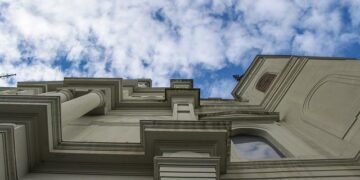Travel
A cycling tour through the lowlands of central Emilia-Romagna reveals the gastronomic highs of Italy’s ‘food valley’.
ByDuncan Craig
Photographs ByFrancesco Lastrucci
Published January 17, 2024
This story was produced by National Geographic Traveller (UK).
Hands clasped firmly behind his back, with the beady vigilance of a parade-ground sergeant major, Alessandro Ferrarini strides among his massed ranks of cheese.
Several thousand recruits are lined up. Evenly spaced and immaculately presented, they stand on rows of shelves reaching almost to the ceiling.
Alessandro — the fleece beneath his waxy, army-green lab coat zipped up to the neck against the carefully calibrated cold — is here to sniff out imperfection. He spots a suspect, wrestles it expertly down from the shelf onto a wooden stool and sets about it with a hammer. A very small hammer.
“You’re listening for a higher pitch,” he says, tapping delicately at the base of the 45kg wheel and squinting as he gauges the reverberations. “That would betray a crack, a void. Weakness.” The penalty? “Downgraded. It won’t make selection. Standards are very, very high.”
It’s a Darwinian existence, the world of parmigiano reggiano, but it didn’t start out that way. Eight centuries ago, when Benedictine monks first began ageing wheels of cow’s milk in a fertile, sun-drenched river valley a couple of dozen miles east of here, it was simply a tentative experiment in food preservation. But so sought-after proved their salty, granular and unusually versatile creation, that every stage of this monastic alchemy would ultimately find itself wrapped in a stringent cloak of regulation.
The production technique — which I’ve just witnessed in a series of adjacent rooms here at Hosteria Bertinelli, a cheese producer, deli and restaurant west of Parma in northern Italy’s Emilia-Romagna region — remains markedly unchanged since parmigiano reggiano’s inception: the separation of cheese curds from whey in vast copper vats; the shaping in moulds; the month-long immersion in salt baths, in which the fleshy wheels glow beneath the briny surface like alien creatures in a dystopian fantasy.
Finally, the ageing in a room such as this: a turophile temple where the cheese matures for a minimum of 12 months, and anything up to three years — when it takes on a nutty, crumbly, almost honeycombed quality with which I’m to develop an unhealthy fixation.
Alessandro is not quite il casaro or ‘master’ — the big cheese, if you will. But the 54-year-old is a vital cog in the production of these parmigiano reggiano wheels, and it’s one he manifestly loves. “I never tire of it,” he says. “It’s probably not good for the cholesterol, but hey.” He gives a happy shrug of indifference.
Just a few hundred producers in the region are entrusted with the creation of this globally revered product. Surely there must be rivalry, I ask. Alessandro looks contemplative. “I’d describe it as more of a collective,” he says. “To keep these traditions alive — that’s in all of our interests.”
It’s a sentiment I’m to hear repeatedly during the course of my two-wheeled meander across central Emilia-Romagna. Ernest Hemingway once said that “it is by riding a bicycle that you learn the contours of a country best, because you have to sweat up the hills and freewheel down them”. He clearly never saddled up on a hybrid bike with a handlebar basket and pootled through the unerringly flat landscape of Italy’s ‘food valley’.
Cycling in these parts is less about contours than rhythms and flavours. No one’s wearing Lycra or pushing out watts; this is effortless pedalling, punctuated by protracted lunches, indulgent pasticceria (pastry shop) pit stops and picnics on the stoops of semi-derelict farmhouses pondering sweeping life changes.
The mighty Po river, which marks the northern border of much of Emilia-Romagna, was once known for being a shapeshifter; you never really knew what course it was going to take. And it’s in that spirit that a cycle trip here should be undertaken — following word of mouth as much as maps over the course of the week, with luggage ferried on each day to your chosen base to free up pannier space for gastronomic impulse buys.
And there’ll be plenty; nowhere in the world has a higher density of PDO (Protected Designation of Origin) or PGI (Protected Geographical Indication) products: there’s parmigiano reggiano, of course, but also prosciutto di parma and prosciutto di modena; the even more highly prized culatello, from the muscular haunches of the pig; balsamic vinegar; anguria reggiana watermelons; vignola cherries, and dozens more.
Saddle up
I begin in Parma, the ultimate gourmand-cyclist base camp. Hosteria Bertinelli and its cheeses are a short ride west, across the sprawling Taro, a tributary of the Po; northwest lies the commune of Polesine Zibello, whose persistent winter fogs infuse its culatello with a uniquely sweet flavour. But I don’t want to neglect the city itself.
I fortify myself with an aperitivo at Enoteca Fontana — a salmon-hued cantina on the thoroughfare of Strada Luigi Carlo Farini from which ebullient young Parmigiani spill, laden with €5 (£4.30) prosciutto crudo and glasses of fruity white Malvasia secca.
Across the street is La Prosciutteria, an Italian deli straight out of a Richard Curtis movie. The trick is to avoid tormenting yourself among its flawlessly presented wines, pastas and salumi (culatello di zibello is €130/£113 per kilogram, I note), and instead nip around the side to sister restaurant Degusteria. It’s intimate — just 30-odd covers, with a coppery-red interior and boxed-glass frontage consumed by climbing plants.
With chef Francesco Bonofiglio looking on, an expectant smile framed by his pencil-thin moustache, I’m initiated into the world of anolini in brodo: smooth, taut discs of pasta, filled with slow-cooked veal and spices and served in a richly aromatic broth with a dusting of 24-month parmigiano reggiano.
Nothing about this dish, thought by many to originate from Parma, is convenient — the veal took eight hours to cook, the broth four, Francesco informs me. The memory of the richness of the flavour, the warmth in the pit of the stomach, the sheer damn perfection of it stays with me for days.
Striking out east the following morning, the prosaic suburbs of Parma quickly fall away, replaced by expansive fields, shuttered casale farmhouses shaded by rows of poplars and grand villas with pleached lime trees of buttery autumnal yellow. Near the village of Basilicagoiano, I spot a farmer steadily ploughing a rectangular swathe into a boulder field the colour of dark chocolate. White, heron-like little egrets fan out behind him, like an animated bridal train, picking at the soil.
The farmer waves. I wave. He stops, kills the engine and we chat for a while, the buzz of a biplane in the hazy autumnal sky and a persistent cuckoo the only other sounds. This is 20-year-old Francesco Mattiloi. He’s prepping the field for alfalfa, he says, which is the purple-flowering, highly nutritious cornerstone of the diet on which cows supplying milk to parmigiano reggiano producers must be fed. His family have 400 cows of their own, on a nearby farm started by his father’s grandfather in 1902.
Francesco is wearing a red T-shirt, board shorts and a broad, guileless smile. His air-conditioned, 200-horsepower tractor may have put a bit of a gap between his work and the backbreaking toil of his great-grandfather, but Francesco’s connection to the land seems no less ardent. He insists on showing me the cows, swinging the tractor around and bouncing off down the leaf-strewn lane as I cycle behind.
We find his mother drying handfuls of porcini mushrooms on a gigantic whiteboard that’s been laid out in the sun. The herd of black-and-white cows, which Francesco proudly shows off like a fleet of Ferraris, is chewing mouthfuls of hay to the rear.
A short distance from the Mattiloi family farm is the border between Parma and Reggio Emilia — defined by the venous waters of the Enza river. Viewed on a map, the nine provinces of Emilia-Romagna resemble plump ciabattas squeezed together in a nonna’s shopping basket. And it’s handy to think of them this way: equally appetising but entirely discrete entities, in which dishes and delicacies freely available in one province can mysteriously vanish from counters just a few hundred yards away.
Crossing into Reggio Emilia, erbazzone becomes ubiquitous. It’s a slender pastry hailing from these parts that’s stuffed with spinach or boiled beet tops, shallots and onion. Torta di riso is particularly prized here, too: a cake-like dessert made from rice, pine nuts and almonds, brushed with sassolino — an aniseed-flavoured liquor. I sample the latter in Panificio Melli, a pasticceria buried in the labyrinthine old town of ‘Reggio’, the de facto provincial capital, which I roll into late afternoon, mudguards rattling percussively on the compact cobbles. Stone columns support an arched ceiling of bare brickwork and the place is packed with animated locals.
“Choose the dimensions of your slice,” says the lady behind the counter, grandly, as she hovers her knife above a glisteningly gluttonous yellow wheel of the torta di riso. I hold off for as long as I dare, then pay for the resulting wedge by weight, and twin this with a couple of sugar-coated tortelli dolci, mini doughnut-like pillows, one filled with cream and the other with chocolate, coffee and marmalade.
Panificio Melli sits just across the square from the Basilica di San Prospero. Like much of this city — established two millennia ago as a staging post on the Romans’ newly built Via Emilia trunk road — the church is a compelling amalgam of historical layers. It’s renaissance in style, with a late baroque pinkish-brown facade.
The extraordinary La Notte painting, by Antonio di Correggio, was taken from the basilica by the area’s ruling duke in 1640 — a copy of the chiaroscuro-crafted masterwork sits in one of the side chapels, so you can see what you’re missing. But the frescoes that adorn the cupola and apse offer some consolation. With my bike propped up in the square outside, I slide into a pew at the front of the nave and spend a neck-cricking hour picking out tiny details from the dense ascension of figures above — an artistic, if not quite religious, conversion.
Among the vines
East of Reggio, the landscape shifts perceptibly. Pastoral and arable land gives way to the viticultural: hobby vineyards at first, morphing into endless stripes that strobe my peripheral vision — the vines so established in places that their aged, sun-darkened branches touch across rows like gnarly fingers.
Lambrusco has never been the most revered of Emilia-Romagna’s indigenous produce, it’s fair to say. This patently irks Samuele Goldoni. At the Lusvardi vineyard, around 10 miles east of Reggio, the long-haired 28-year-old and his small team are engaged in the production of what, until not so long ago, would have been regarded as a snigger-inducing oxymoron: high-quality Lambrusco.
Theirs is a small outfit: 40,000 bottles per year, 11 labels, two grapes. The vineyard started in 2008 on land once used for pigs. Samuele takes me on a tour of the 8.5-acre plot where the bluey-black Lambrusco Salamino grape thrives in the water-retaining clay soils.
They prune by hand, focusing on quality not quantity, a striking inversion of the Lambrusco way. “Usually after 15 years Lambrusco vines are replaced because the quantity goes down, quality goes up,” he tells me. “Our approach is to persevere.” There’s a focus on sustainability: Samuele shows me the solar panels that power the container fridge and the living roof on the winery that provides both insulation and a barrier to overheating. We stand for a moment, enjoying the stillness. Away to the west, the sun sets over the toothy outline of the Apennines.
The subsequent tasting is an exuberant affair, bottles popping with Grand-Prix-podium abandon. Samuele sniffs every cork heartily as it’s pulled, a little involuntary smile playing across his lips on each occasion.
“For too long the good name of Lambrusco has been dragged through the mud,” he says, topping up my glass with Lusvardi Rose, the flagship sparkling, with its spirited notes of berries and green apple. “Now it’s starting to be known that good-quality Lambrusco exists.” He pauses, more emphatic now: “People have to know.”
A very different style of tasting provides the highlight of my final day in the saddle. It’s Lambrusco again — in a sense. Overnighting in the town of Correggio, where vintage Lamborghini tractors are arranged artfully beneath the expansive, marble-paved porticoes of Piazza Mazzini, I set a course for Acetaia Giusti, just north of Modena.
My nose tells me I’ve arrived before the satnav does: a bubble of sweetness hangs over the balsamic vinegar producer’s bucolic cluster of restored 19th-century buildings like woodsmoke, and escapes down the surrounding lanes.
Balsamic vinegar is Modena’s most famous export, and this company was the royal supplier to the last king of Italy. Claudio Stefani Giusti, who greets me with a warm handshake as I crunch into the acacia-shaded courtyard, is a 17th-generation producer.
The adjacent museum tells the venerable backstory and attempts to explain the ritual and rigour involved in creating this ‘perfume for the food’; the extraction of the juice from the Lambrusco and Trebbiano grapes; the simmering, fermenting and maturing. But theory only gets you so far. Across the courtyard, in the aromatic shadows of the ageing rooms, lie some 5,000 dark wooden casks. Each is open at the top to allow for evaporation, and arranged in batches of progressively decreasing size. Some are juniper; others oak, cherry or mulberry — each variety serving to gently infuse the maturing vinegar with a unique flavour. It’s a perpetual cycle of decanting and refilling, with the final product bottled from the smallest, most piquantly scented cask.
It’s from one of these that Madalena Gibellini draws a sample using a sharply elongated pipette. She lights a candle to check for impurities in the time-honoured way, suffusing the reverential gloom with a warm glow. Satisfied, she carefully hands me a white ceramic spoon filled with a glossy, viscous liquid that started its journey a few years after the end of the First World War.
I invert the spoon in my mouth, as instructed, and press the liquid into my tongue. Notes of black cherry. Tamarind and chocolate. Liquorice. “It’s a party in your mouth,” says Madalena. It is, but there’s also an elixir quality; I can see why, for centuries, balsamic vinegar was feted for its health-giving properties. “My nonna still puts a few drops on a teaspoon when she’s unwell,” says Madalena.
Working here reminds her to be mindful, she tells me. “What I love is that there can be no shortcuts. We have to be passionate to do a great job but we also must be patient.”
My last few miles offer a final reminder of the enduring satisfaction of two-wheeled travel: it’s fast enough to outrun mundanity, as I do with Modena’s persistently charmless suburbs, yet it’s slow enough to enjoy the unfurling of the nucleus of a historic European city. Nimble, too; while the Modenese motorists honk themselves to a standstill, I glide directly up to the Ghirlandina belltower, the 295ft-high spectral beacon that serves as the city’s totem.
It’s to be a final evening of indulgence. Local staple gnocco fritto — golden pillows of lard-enriched dough draped in silken sheets of culatello; the flourless torta barozzi — the ‘black cake of Modena’ — a delectable concoction of chocolate, peanuts, almonds, coffee and often rum; and, of course, tortellini.
The distinctive pasta parcels are still rolled by hand in the little kitchen above Salumeria Hosteria Giusti, a revered deli-restaurant a couple of streets from Modena’s 12th-century cathedral. Its modest olive-green facade is adorned with 3D gold-leaf lettering. Ceramic floral ceiling lamps light the interior. Its understated restaurant, tucked away in a former butcher’s out back, is one of the city’s most sought-after reservations.
The small tray of handcrafted tortellini behind the counter — pristine, delicate parcels of pork, mozzarella, nutmeg and parmigiano reggiano — has been made by Candida Mangone. It’s a slow process, she explains: a kilogram in an hour, on a good day.
She nudges her younger colleague, Anna Spaliviero, who offers me a small scoop. It’s not in a slow-cooked broth, nor sprinkled with a sedulously crafted parmigiano-reggiano, just raw, in the fingertips — as generations of Italian children will have enjoyed them, furtively leaning over their grandmother’s shoulder in the kitchen at Christmas. And it’s sublime.
As I chat to the duo, quizzing them on dishes’ ingredients and provenance, the clock ticks past closing time. I’m reminded of something Madalena confided to me earlier in the day. “I realised recently that the only time I wasn’t talking about food or thinking about food was when I was eating,” she’d said, with a laugh.
After a week cycling through Emilia-Romagna, I’m clearly on that very same road to obsession.
Getting there and around
No airlines fly direct to Parma from the UK. Multiple airlines fly from London, Manchester and other UK airports to Milan (80 miles from Parma) or Bologna (30 miles from Modena) year-round, including British Airways, Swiss and EasyJet.
Average flight time: 2h30m.
Alternatively, train travel is possible from London St Pancras to Parma, with changes in Paris, Geneva and Milan.
Average journey time: 15h. Trenitalia offers regular services that connect Parma, Reggio-Emilia and Modena with Milan and Bologna.
Best time to visit
Emilia-Romagna’s climate is mild and dry. Autumn and spring are rewarding times to visit, when the mugginess of summer eases but temperatures still touch 25C. Winters in the Po Valley are cool, wet and foggy.
Where to stay in Emilia- Romagna
Hotel Button, Parma. Doubles from £70, B&B.
Hotel Posta, Reggio-Emilia. Doubles from £100, B&B.
Hotel dei Medaglioni, Correggio. Doubles from €114 (£99), B&B.
Hotel Canalgrande, Modena. Doubles from €165 (£144), B&B.
How to do it:
Inntravel offers a six-night, self-guided cycle tour of central Emilia-Romagna from £1,010 per person. Price includes stays in three four-star hotels and one three-star (all B&B), bike hire, route notes, maps, GPS navigation and daily luggage transfers. Excludes flights or rail travel from the UK.
More information
Northern Italy: Emilia-Romagna. £16.99.
bradtguides.com
This story was created with the support of Inntravel.
Published in the Jan/Feb 2024 issue of National Geographic Traveller (UK).
To subscribe to National Geographic Traveller (UK) magazine click here. (Available in select countries only).
>>> Read full article>>>
Copyright for syndicated content belongs to the linked Source : National Geographic – https://www.nationalgeographic.com/travel/article/culinary-adventure-through-emilia-romagna-italy-on-bicycle






























